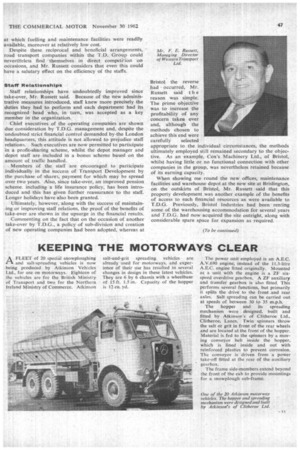KEEPING THE MOTORWAYS CLEAR
Page 49

If you've noticed an error in this article please click here to report it so we can fix it.
AFLEET of 20 special snowploughing and salt-spreading vehicles is now being produced by Atkinson Vehicles Ltd., for use on motorways. Eighteen of the vehicles arc for the British Ministry of Transport and two for the Northern Ireland Ministry of Commerce. Atkinson salt-and-grit spreading vehicles are already used for motorways, and experience of their use has resulted in several changes in design in these latest vehicles, They are 6 by 6 chassis with a wheelbase of 15 ft. 1.5 in Capacity of the hopper is 12 cu. yd.
The power unit employed is an A.E.C. A.V.690 engine, instead of the 11.3-litre A.E,C. engine fitted originally. Mounted as a unit with the engine is a ZF sixspeed overdrive gearbox. A ZF auxiliary and transfer gearbox is also fitted. This performs several functions, but primarily it splits the drive to the front .and rear axles. Salt spreading can be carried out at speeds of between 30 to 35 m.p.h.
The hopper and its spreading mechanism were designed, built and fitted by Atkinson's of Clitheroe Ltd., Clitheroe, Lancs. Twin spinners throw the salt or grit in front of the rear wheels and are located at the front of the hopper. Material is fed to the spinners by a moving conveyor belt inside the hopper, which is lined inside and out with reinforced plastics to prevent corrosion. The conveyor is driven from a power take-off fitted at the rear of the auxiliary gearbox.
The frame side-members extend beyond the front of the cab to provide mountings for a snowplough sub-frame.




































































































